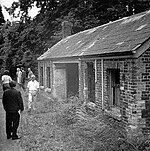Chudleigh Knighton Halt railway station

Chudleigh Knighton Halt was on the Teign Valley Line serving the small village of Chudleigh Knighton, Devon, England. The halt, built by the Great Western Railway at a later date than most of the other stations on the line, was located on the west side of Pipehouse Lane off the B3344, to the south of the village. The first station was constructed of timber with a small corrugated iron pagoda shelter and a simple nameboard, at a cost £300. After WW2 a concrete platform was provided. A level crossing was located at the platform end. The track was still in situ in 1969, but goods facilities were withdrawn on 4 December 1967. Passenger numbers reached their peak in the 1930s with seven daily services provided each way between Exeter and Heathfield. During World War 2 this was reduced to four trains in each direction, still with no trains on a Sunday. This was increased to five daily trains after the war.The A38 road now runs over the site of the halt and nothing remains of the station.
Excerpt from the Wikipedia article Chudleigh Knighton Halt railway station (License: CC BY-SA 3.0, Authors, Images).Chudleigh Knighton Halt railway station
Devon Expressway, Teignbridge Hennock
Geographical coordinates (GPS) Address Nearby Places Show on map
Geographical coordinates (GPS)
| Latitude | Longitude |
|---|---|
| N 50.582 ° | E -3.633 ° |
Address
Devon Expressway
Devon Expressway
TQ12 6RD Teignbridge, Hennock
England, United Kingdom
Open on Google Maps









